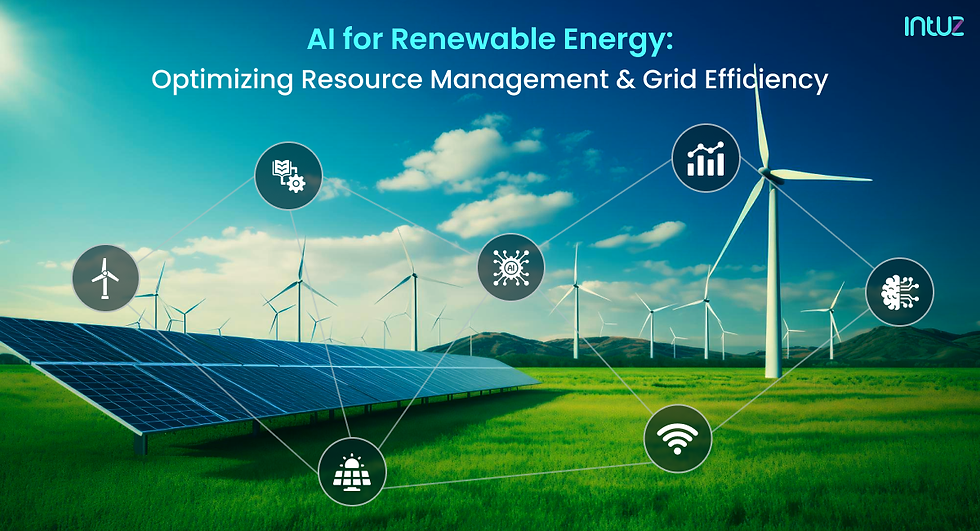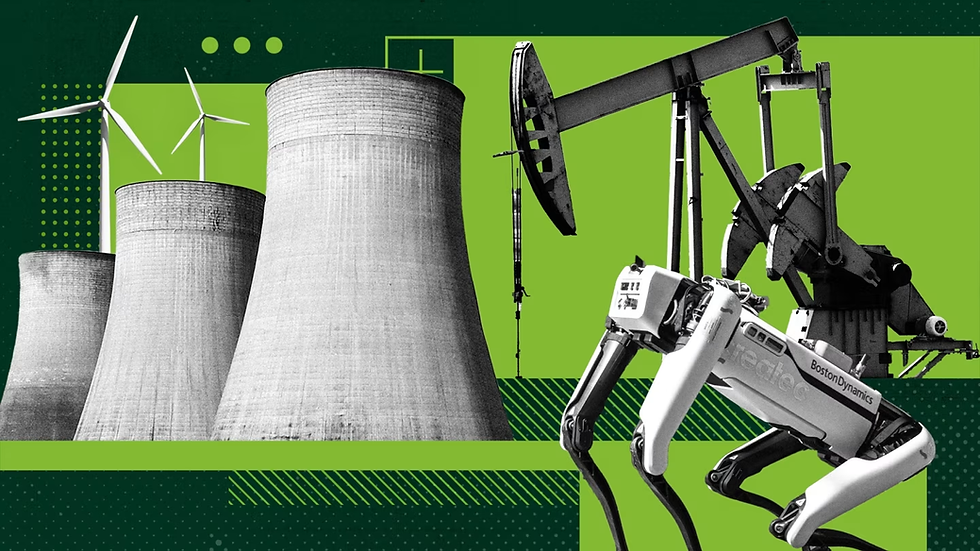The Shocking Rise of AI Energy Consumption: What It Means for Our Planet’s Future
- Olivia Johnson

- Aug 5
- 11 min read

Artificial Intelligence (AI) is transforming industries, revolutionizing how we work, live, and solve complex problems. However, behind its impressive capabilities lies a growing concern that often goes unnoticed—the massive increase in energy consumption driven by AI technologies. As AI models grow larger and more complex, their energy demands surge, posing significant environmental challenges that could jeopardize our planet’s future if left unaddressed.
In this comprehensive article, we explore the shocking rise of AI energy consumption, dissect the implications for global sustainability, and highlight what must be done to balance innovation with environmental stewardship. Readers will gain valuable insights into the scale of AI’s energy footprint, the drivers behind this growth, and practical strategies to mitigate its impact.
Understanding AI Energy Consumption: What’s at Stake?

As AI technologies advance, their computational requirements increase exponentially. But why does AI consume so much energy? The answer lies in the nature of modern AI systems, especially deep learning models that require massive amounts of data processing and training on specialized hardware such as GPUs and TPUs.
AI energy consumption refers to the amount of electrical power required to train, deploy, and operate artificial intelligence models.
This energy use extends beyond just running a single model; it includes data centers' cooling systems, network infrastructure, and hardware manufacturing—all contributing to the overall environmental cost.
Why Should We Care?
Rising Energy Demand: Data centers worldwide already consume about 1% of global electricity, a figure expected to grow with AI’s adoption. For example, companies like Google and Amazon operate hyperscale data centers that house hundreds of thousands of servers. The more AI workloads these centers handle, the more electricity they consume. This increase is not linear; as AI models grow more complex, energy usage can rise exponentially.
Carbon Emissions: Many data centers rely on fossil fuels, meaning increased AI use can directly increase greenhouse gas emissions. For instance, data centers located in regions powered predominantly by coal or natural gas contribute disproportionately to carbon emissions. Even with the adoption of renewable energy in some regions, the global disparity in energy sources means that AI's carbon footprint remains a concern.
Resource Constraints: Beyond energy, AI hardware production requires rare materials and water usage, intensifying environmental strain. Manufacturing GPUs and TPUs involves mining for rare earth elements like neodymium and tantalum, which are often extracted in environmentally damaging ways. Additionally, manufacturing processes consume significant water volumes, contributing to local water scarcity issues in mining regions such as the Democratic Republic of Congo or parts of China.
Understanding these stakes is crucial because AI’s benefits must not come at an unsustainable environmental price. The challenge lies in harnessing AI’s transformative power while reducing its ecological footprint to safeguard planetary health for future generations.
The Growth of AI Models and Their Energy Demands

AI models have evolved rapidly from simple algorithms to enormous neural networks with billions of parameters. This growth, while enabling breakthroughs in language processing, computer vision, and autonomous systems, also drives up energy consumption dramatically.
The Explosion in Model Size
GPT-3, developed by OpenAI, has 175 billion parameters—a scale unimaginable a decade ago. This massive parameter count allows GPT-3 to generate human-like text, translate languages, and even write code, but training it required an estimated 1,287 MWh of electricity, comparable to powering over 100 average US homes for a year.
Newer models like GPT-4 and Google's PaLM push these boundaries even further, with GPT-4 rumored to have trillions of parameters. Such models enable more sophisticated reasoning, multi-modal understanding, and nuanced interactions but come with even higher energy costs.
Beyond language models, AI in computer vision has also seen growth. Models like EfficientNet and Vision Transformers (ViT) utilize billions of parameters to improve image classification and object detection accuracy, directly impacting applications from medical diagnostics to autonomous vehicles.
Comparing Energy Use Over Time
Model | Parameters (Billions) | Estimated Training Energy (MWh) | Equivalent CO₂ Emissions (tons) |
|---|---|---|---|
AlexNet (2012) | 0.06 | ~0.01 | ~5 |
BERT (2018) | 0.34 | ~1 | ~284 |
GPT-3 (2020) | 175 | ~1287 | ~552 |
Note: These figures vary based on hardware efficiency and data center location.
The takeaway is clear: AI model complexity correlates strongly with energy consumption, raising concerns about scalability and sustainability. For example, training GPT-3 required thousands of GPUs running continuously for weeks, consuming enormous amounts of electricity and necessitating advanced cooling solutions to prevent overheating.
Real-World Application Scenarios
Natural Language Processing (NLP): Large language models power chatbots, virtual assistants, and automated translation services. For instance, customer service chatbots deployed by banks handle millions of queries daily, requiring continual inference runs on these large models, translating to ongoing energy use.
Autonomous Vehicles: Self-driving car AI systems rely on complex models for real-time decision-making. These models run on edge devices with limited power budgets but require frequent retraining to improve safety and performance, incurring energy costs during development.
Healthcare Diagnostics: AI models analyze medical images or genomic data to assist diagnosis. Training these models on vast datasets demands substantial computational resources and energy, especially when incorporating multi-modal data like MRI scans and patient records.
Quantifying AI’s Environmental Footprint

To grasp the true impact of AI energy consumption, it is essential to quantify both direct and indirect environmental effects.
Direct Energy Consumption
Training large models can consume hundreds to thousands of MWh per run. For example, training GPT-3 reportedly consumed energy equivalent to the annual electricity usage of 126 average US households.
Inference or deployment energy depends on model size and usage frequency. While training is energy-intensive over a short period, inference occurs continuously as models serve millions of users. For instance, a widely used voice assistant processes billions of requests monthly, cumulatively consuming significant energy.
Edge AI deployments, such as AI on smartphones or IoT devices, consume less energy per operation but scale massively, with billions of devices worldwide contributing to aggregate energy use.
Indirect Environmental Costs
Cooling systems in data centers can account for up to 40% of total energy use. Data centers require constant cooling to maintain optimal operating temperatures for servers. Techniques include air conditioning, liquid cooling, and immersion cooling. Each method has different energy profiles and environmental impacts. For example, immersion cooling reduces energy use but requires specialized infrastructure.
Manufacturing GPUs and other components involves mining rare earth elements that cause ecological damage. Extraction processes often involve hazardous chemicals, deforestation, and soil contamination. Mining operations can displace local communities and cause biodiversity loss.
Electronic waste from hardware upgrades adds to environmental burdens. AI hardware often becomes obsolete quickly due to rapid advancements, leading to discarded servers and components. Many e-waste recycling systems struggle to recover rare materials efficiently, leading to pollution and health hazards in regions where informal recycling occurs.
Global Carbon Emissions
Estimates suggest that training a single large AI model can emit as much carbon as five cars over their lifetimes. With millions of models being developed globally, cumulative emissions are significant.
Data centers contribute approximately 0.3% of global CO₂ emissions; however, as AI workloads increase, this percentage could rise substantially. For context, this is comparable to the aviation industry’s share of emissions, signaling the need for urgent intervention.
The carbon intensity of AI training depends on the energy mix of the data center location. For example, training in regions powered by coal results in higher emissions than in areas with abundant renewable energy.
Drivers Behind the Rising Energy Usage in AI

Several factors contribute to the rapid increase in AI energy consumption. Understanding these drivers is vital for designing effective mitigation strategies.
1. Increasing Model Complexity
As AI tackles more sophisticated problems, models grow exponentially in size and depth. Larger models require more floating-point operations per second (FLOPS) to train and run. For example, transformer architectures, which underpin many modern AI models, scale quadratically with input size, meaning computational needs skyrocket as data and model size increase.
Complex models also require more hyperparameter tuning and experimentation, multiplying the number of training runs.
Additionally, models with billions of parameters demand distributed training across multiple GPUs or TPUs, increasing overall energy use due to inter-device communication overheads.
2. Data Explosion
The availability of massive datasets fuels AI performance improvements but also increases energy demands.
Training on datasets with billions of examples requires longer compute times and more data storage.
Data preprocessing, augmentation, and cleaning steps consume additional computational resources.
For example, image recognition models trained on datasets like ImageNet or Open Images involve processing millions of high-resolution images, each requiring significant processing power.
3. Hardware Inefficiencies
Not all hardware is created equal in terms of energy efficiency.
Older data centers or GPUs often consume more power per operation than newer, optimized units.
Many AI workloads still run on general-purpose GPUs rather than specialized AI accelerators, which are more energy-efficient.
Some data centers lack access to renewable energy or efficient cooling, increasing their carbon footprint.
For example, AI workloads running in regions with outdated infrastructure can have energy costs up to 2-3 times higher than those running in state-of-the-art facilities.
4. Proliferation of AI Applications
AI is no longer confined to research labs; it powers countless applications worldwide.
Voice assistants like Siri and Alexa process billions of requests daily, requiring continuous inference computations.
Autonomous drones and robots deploy AI models onboard, necessitating constant energy use.
AI-driven content recommendation engines on platforms like YouTube and Netflix run complex models to personalize user experiences, consuming energy at scale.
The aggregate effect of these applications significantly raises overall AI energy consumption.
5. Research and Experimentation
Developing new AI models involves numerous training cycles.
Researchers often train multiple model variants to optimize performance, each consuming substantial energy.
Hyperparameter optimization techniques like grid search or evolutionary algorithms multiply energy use.
For instance, OpenAI’s GPT-3 training involved extensive experimentation with model architectures and training regimes, increasing total energy consumption beyond the final training run.
Microsoft's sustainability efforts provide an example of how cloud providers are attempting to reduce operational carbon footprints: Microsoft Sustainability Report.
The Global Environmental Impact: Climate Change and Beyond

The environmental consequences of rising AI energy consumption ripple across multiple dimensions, affecting ecosystems, resources, and human communities.
Climate Change Acceleration
Increased carbon emissions from AI-related activities exacerbate global warming effects.
The carbon footprint of AI contributes to greenhouse gas accumulation, intensifying climate change impacts such as rising sea levels, extreme weather, and biodiversity loss.
AI advancements ironically also aid climate science, creating a paradox where AI both contributes to and helps combat climate change.
For example, AI models used in climate modeling require significant computational resources but provide crucial insights for mitigation strategies.
Resource Depletion
Mining for semiconductors uses water and rare minerals like cobalt and lithium, leading to habitat destruction and pollution.
Extraction processes often occur in ecologically sensitive areas, such as the Amazon rainforest or Central African mines.
Water-intensive mining exacerbates local water shortages, affecting agriculture and drinking water supplies.
For instance, lithium mining in Chile’s Atacama Desert consumes vast water quantities, threatening fragile ecosystems.
Electronic Waste Generation
Short hardware upgrade cycles produce significant e-waste, challenging recycling infrastructure.
AI hardware rapidly becomes obsolete due to fast-paced innovation, leading to discarded devices.
Improper disposal of e-waste releases toxic substances like lead and mercury into the environment.
Developing countries often bear the brunt of e-waste dumping, causing health issues for local populations.
Social Implications
Communities near mining operations or data centers may face health risks or resource constraints.
Mining activities can displace indigenous populations and disrupt traditional livelihoods.
Data centers require large water volumes for cooling, potentially straining local supplies, especially in arid regions.
For example, Facebook’s data center in Prineville, Oregon, has invested in water recycling to mitigate local impacts, but many facilities lack such measures.
Innovations and Solutions to Reduce AI’s Energy Consumption

Addressing the escalating energy demands of AI is a multi-faceted challenge requiring technological innovation, policy interventions, and industry collaboration.
Energy-Efficient Hardware
Development of specialized chips like Google’s TPU v4 optimized for AI workloads significantly improves performance per watt compared to general-purpose GPUs.
New architectures such as neuromorphic chips mimic brain processing, potentially reducing energy consumption drastically in future AI systems.
Adoption of low-power processors in edge AI devices balances performance with battery life, enabling AI applications in mobile phones and IoT devices without excessive energy use.
For example, Apple’s Neural Engine in its A-series chips accelerates AI tasks efficiently, reducing reliance on cloud computations.
Algorithmic Improvements
Techniques like model pruning remove redundant parameters from neural networks, reducing computation without sacrificing accuracy.
Quantization lowers numerical precision of model weights, enabling faster and less energy-intensive operations.
Knowledge distillation transfers learned behavior from large models to smaller ones, preserving performance with lower energy costs.
Efficient training methods such as transfer learning leverage pre-trained models, reducing the need for full retraining.
For instance, many companies fine-tune BERT or GPT models on domain-specific data rather than retraining from scratch, saving energy and time.
Renewable Energy Adoption
Data centers powered by wind, solar, or hydroelectric sources can drastically cut net emissions.
Tech giants like Google and Microsoft have committed to running their data centers on 100% renewable energy.
Innovative cooling solutions using ambient air or seawater reduce electricity consumption.
Location choice plays a role: data centers built in cold climates like Finland or Iceland benefit from natural cooling.
For example, Facebook’s data center in Luleå, Sweden, uses hydroelectric power and ambient cooling to minimize its carbon footprint.
Software Optimization
Better software frameworks enable more efficient use of computational resources.
Optimized libraries like NVIDIA’s cuDNN and TensorFlow’s XLA compiler reduce unnecessary computations.
Dynamic batching and caching can lower inference energy by grouping requests or reusing computations.
Cloud providers offer autoscaling to match resource allocation with workload demand, avoiding idle energy waste.
Regulatory Measures & Transparency
Encouraging companies to disclose their AI energy footprints fosters accountability and drives improvement.
Standards for reporting AI energy use, akin to carbon accounting in manufacturing, are emerging.
Governments can incentivize green data centers through tax credits or mandates.
Industry consortia promote best practices and certifications for sustainable AI operations.
The Green Software Foundation provides guidelines and tools for sustainable software engineering practices: Green Software Foundation.
Balancing AI Advancement with Sustainable Practices

The future of AI must align innovation with ecological responsibility:
Stakeholders including researchers, corporations, governments, and consumers must prioritize sustainability. For example, research institutions can include energy efficiency as a key metric for model evaluation.
Incentives for green data centers, investment in clean energy infrastructure, and support for research into efficient AI models are critical. Public-private partnerships can accelerate development and adoption of sustainable technologies.
Educating developers about the environmental cost of training large models encourages more mindful design choices. Workshops and courses on sustainable AI practices are increasingly offered by universities and industry groups.
Promoting AI for good initiatives that leverage AI to address environmental challenges—such as climate modeling, biodiversity monitoring, and energy optimization—can help balance the scales.
Sustainability in AI is not just an option—it’s imperative to ensure that technological progress benefits humanity without compromising our planet.
Frequently Asked Questions (FAQ)
Q1: Why does training an AI model consume so much energy?
Training requires running billions or trillions of calculations repeatedly across large datasets using power-intensive GPUs or TPUs for days or weeks, which collectively consumes substantial electricity. This process involves forward and backward passes through neural networks, gradient calculations, and parameter updates, all of which are computationally expensive.
Q2: Can smaller AI models be as effective as large ones?
Yes. Techniques like transfer learning enable smaller models to perform well by building on pre-trained larger models, reducing training time and energy consumption. Additionally, methods like model distillation compress large models into smaller, faster versions suitable for deployment without significant loss in accuracy.
Q3: How can consumers influence the sustainability of AI?
By supporting companies committed to green computing practices, choosing products powered by renewable energy, and advocating for transparency in tech companies’ environmental impact. Consumers can also reduce unnecessary AI usage—for example, limiting excessive voice assistant queries or data-intensive app usage—to lower demand.
Q4: Are there regulations addressing AI’s environmental footprint?
Currently limited but growing; some governments incentivize green data centers and sustainable IT practices. Industry-led initiatives also push for voluntary standards. Future regulations may require mandatory reporting of AI energy consumption and carbon emissions, similar to environmental standards in other sectors.
Q5: What role do cloud providers play in reducing AI’s energy use?
Cloud providers invest heavily in renewable-powered data centers and optimize infrastructure efficiency—users leveraging cloud computing indirectly benefit from these sustainability efforts. Providers also offer tools to monitor and optimize AI workloads’ energy consumption, enabling more sustainable AI development.
Conclusion: Charting a Sustainable Path Forward for AI
The shocking rise in AI energy consumption is a pressing issue that demands urgent attention. While the transformative potential of artificial intelligence is undeniable, its environmental cost cannot be ignored. By understanding the scale of energy use involved, recognizing the drivers behind this trend, and embracing innovations that promote efficiency and sustainability, we can strive for a future where AI advances hand-in-hand with planetary health.
As stakeholders across sectors unite around this mission, continued progress will depend on transparent reporting, investment in green technologies, and responsible innovation that values both human progress and ecological integrity.
By integrating these insights into your understanding or operations involving AI technologies, you contribute toward shaping a future where artificial intelligence empowers society without compromising our planet's well-being.

